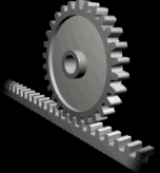
Rack and pinion
Overview
Linear actuator
A linear actuator is an actuator that creates linear motion .Mechanical and hydraulic actuation are the most common methods of achieving the linear motion...
that comprises a pair of gear
Gear
A gear is a rotating machine part having cut teeth, or cogs, which mesh with another toothed part in order to transmit torque. Two or more gears working in tandem are called a transmission and can produce a mechanical advantage through a gear ratio and thus may be considered a simple machine....
s which convert rotational motion into linear motion. A circular gear called "the pinion
Pinion
A pinion is a round gear used in several applications:*usually the smallest gear in a gear drive train, although in the case of John Blenkinsop's Salamanca, the pinion was rather large...
" engages teeth on a linear "gear" bar called "the rack
Rack
- Kinds of racks :* Amp rack, short for amplifier rack, a piece of furniture in which amplifiers are mounted* Bicycle rack, a frame for storing bicycles when not in use* Breast...
"; rotation
Rotation
A rotation is a circular movement of an object around a center of rotation. A three-dimensional object rotates always around an imaginary line called a rotation axis. If the axis is within the body, and passes through its center of mass the body is said to rotate upon itself, or spin. A rotation...
al motion applied to the pinion causes the rack to move, thereby translating the rotational motion of the pinion into the linear motion of the rack.
For example, in a rack railway
Rack railway
A rack-and-pinion railway is a railway with a toothed rack rail, usually between the running rails. The trains are fitted with one or more cog wheels or pinions that mesh with this rack rail...
, the rotation of a pinion mounted on a locomotive
Locomotive
A locomotive is a railway vehicle that provides the motive power for a train. The word originates from the Latin loco – "from a place", ablative of locus, "place" + Medieval Latin motivus, "causing motion", and is a shortened form of the term locomotive engine, first used in the early 19th...
or a railcar
Railcar
A railcar, in British English and Australian English, is a self-propelled railway vehicle designed to transport passengers. The term "railcar" is usually used in reference to a train consisting of a single coach , with a driver's cab at one or both ends. Some railways, e.g., the Great Western...
engages a rack between the rails and pulls a train
Train
A train is a connected series of vehicles for rail transport that move along a track to transport cargo or passengers from one place to another place. The track usually consists of two rails, but might also be a monorail or maglev guideway.Propulsion for the train is provided by a separate...
along a steep slope.
The rack and pinion arrangement is commonly found in the steering
Steering
Steering is the term applied to the collection of components, linkages, etc. which will allow a vessel or vehicle to follow the desired course...
mechanism of car
Automobile
An automobile, autocar, motor car or car is a wheeled motor vehicle used for transporting passengers, which also carries its own engine or motor...
s or other wheel
Wheel
A wheel is a device that allows heavy objects to be moved easily through rotating on an axle through its center, facilitating movement or transportation while supporting a load, or performing labor in machines. Common examples found in transport applications. A wheel, together with an axle,...
ed, steered vehicles.

